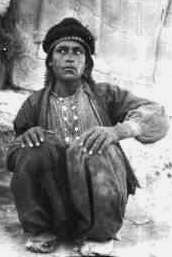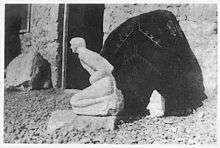Dahoum

Photo: T. E. Lawrence.
Selim Ahmed (c. 1897–1916), also called "Dahoum", meaning "little dark one", was a Syrian Arab boy who worked with T. E. Lawrence at a pre-war archaeological dig at Carchemish.
Early life and work
When Ahmed was twelve years old, he met Lawrence, who was working as an archaeologist with Leonard Woolley at Carchemish, where Ahmed had been hired as a water boy. Lawrence employed Dahoum as an assistant, sending him to investigate Deve Huyuk, a village between Carchemish and Aleppo, where an early gravesite had been discovered.
Ahmed learned English and mathematics from Lawrence, and taught him Arabic in exchange.
Death
In June 1914, Lawrence left Dahoum as custodian at the Carchemish site to return to England and participate in the war effort. Upon his return to Syria in 1918, he discovered Dahoum had succumbed to typhus in 1916.[1]
Relationship with T. E. Lawrence

There were widespread and scandalous allegations that T. E. Lawrence was engaged in a romantic relationship with Selim Ahmed at Lawrence's home in Carchemish, where it was said that Ahmed came to live and where Lawrence had "erected a naked statue of Dahoum".[2] Yet there is no mention of a model in the letter T. E. Lawrence wrote to Will Lawrence on 21 October 1913:
I persuaded Young in his week here to spend his spare time carving gargoyles for the better adornment of the house. He managed in limestone an ideal head of a woman; I did a squatting demon of the Notre-Dame style, also in limestone, and we have now built them into the walls and roof, and the house is become remarkable in N. Syria. The local people come up in crowds to look at them.[2]
In Young's photograph of the statue, it can clearly be seen that the figure has a hook-shaped tail, confirming Lawrence's assertion that the sculpture is intended to be that of a demon. It shows no obvious resemblance to Dahoum, and a model would not be a necessity for such a relatively crude figure any more than for the "ideal(ised) head of a woman" carved by Young. According to Lawrence biographer Jeremy Wilson, however, the photograph was the cause of Leonard Woolley's allegations that
Lawrence, stopping in the house after the dig was over, had Dahoum to live with him and got him to pose as model for a queer crouching figure which he carved in the soft local limestone and set up on the edge of the house roof; to make an image was bad enough in its way, but to portray a naked figure was proof to them of evil of another sort. The scandal about Lawrence was widely spread and firmly believed."[2][3]
Dedication of The Seven Pillars of Wisdom
Lawrence dedicated Seven Pillars of Wisdom to "S.A.":
I loved you, so I drew these tides of men into my hands
and wrote my will across the sky in stars
To earn you Freedom, the seven-pillared worthy house,
that your eyes might be shining for me
When we came.[4]
The identity of "S.A." remains unclear; it has been argued that these initials identify a man, a woman, a nation, or some combination of the above. Lawrence himself maintained that "S.A." was a composite character. One specific claim that has been made is that S.A. is Selim Ahmed.
Notes
- ↑ "Hero: The Life and Legend of Lawrence of Arabia", By Michael Korda
- 1 2 3 Young, Martin (1997). "Hubert Young at Carchemish". The Journal of the T. E. Lawrence Society. 7 (August): 37–42.
- ↑ Wilson, Jeremy (1992). Lawrence of Arabia: The Authorized Biography of T.E. Lawrence. Collier Books. pp. 127–128.
- ↑ Some editions of Seven Pillars give the last line of this stanza as "When we came." The 1922 Oxford text, however, has "When I came."